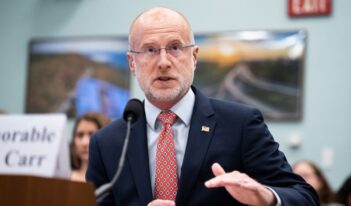
Scholar argues for increased regulation of news media to promote fairness and objectivity.
Americans’ distrust in the media is at an all-time low. Only 9 percent of Americans trust the media “a great deal,” and 60 percent have little to no trust in the media. This distrust is deeply divided along party lines; Republicans and Democrats trust nearly opposite news sources.
One solution to overcome media distrust would be for the Federal Communications Commission (FCC) to reimplement the fairness doctrine, argues Ian Klein in a recent paper. The fairness doctrine required news companies to devote a reasonable amount of coverage to “controversial issues of public importance” and to present contrasting views on the controversial topics.
Klein favors reinstating the fairness doctrine because of the profoundly troubling consequences that distrust in the news media create for U.S. politics. Voters who distrust the media are increasingly acting on incomplete or incorrect information. Furthermore, ideological polarization increases with media distrust because different news sources present contradictory accounts of events—and yet news consumers choose the source that fits better with (and then exacerbates) their own ideological beliefs.
A desire to ensure a knowledgeable electorate motivated the fairness doctrine when it first began to emerge after World War I, when the U.S. Congress passed the Radio Act of 1927. The Radio Act required licenses for broadcasters and for broadcasting to serve the public good.
In 1934, Congress passed the Federal Communications Act, which replaced the Radio Act, and created the FCC to encourage the use of radio for the public interest. Klein explains that at that time the FCC believed that broadcasters were obligated to present all viewpoints on important topics, especially when different parties may disagree, because they served as gatekeepers and disseminators of the news.
Soon after World War II, the FCC published a report containing the mandates for broadcasters that have become known, officially, as the fairness doctrine—to promote fairness in broadcasting and to provide sufficient airtime to objective and non-political coverage of critical events, particularly when there are strong opposing views.
According to Klein, the FCC developed the fairness doctrine because the public has a right to be informed that is more important than the right of broadcasters to share exclusively their views on a topic. Yet, critics of the doctrine worried that it limited freedom of speech too much, threatening the protections of the First Amendment of the U.S. Constitution.
Because of concerns that the fairness doctrine infringed on free speech, the FCC abolished the doctrine in 1985. But according to Klein, the U.S. Supreme Court has never taken the view that the fairness doctrine impermissibly infringed on constitutionally protected free speech.
In fact, in Red Lion Broadcasting v. FCC, the Supreme Court held that the FCC could regulate radio broadcasters because of the importance of the public to receive unbiased, controversial news. The Court also upheld the fairness doctrine because of the scarcity of radio frequencies available, which justified FCC regulation to ensure equal access to finite resources.
The digital age challenges the “scarcity principle” emphasized in Red Lion because modern technology provides a constant flow of information. As a result, the Court could invalidate any modern-day attempt to reinstate the fairness doctrine because it does not fit the scarcity principle. Instead, Klein suggests that the scarcity principle could be applied to a broader conception of scarcity. For instance, viewers have limited time to consume news, and television companies have limited broadcasting timeslots.
Klein also argues that the Court did not uphold the fairness doctrine solely because of the scarcity principle. Rather, the Court upheld the doctrine primarily to protect the public’s right to be informed, which requires unbiased presentation of diverse perspectives on critical issues.
Although Klein encourages the resurgence of the fairness doctrine, he concedes that modern-day news broadcasting has evolved since 1985. For the FCC to reimplement a fairness doctrine that can apply today, it would need to address concerns about infringement on free speech that led to its original demise but also account for new challenges of the digital age.
Klein argues, however, that the benefits of the fairness doctrine would outweigh the potential costs. Access to objective information from diverse perspectives would allow voters to make more informed decisions. According to Klein, the doctrine would also benefit news companies by increasing their credibility and viewership.
Klein emphasizes that the fairness doctrine could solve one of the most pressing problems in America—the perception of biased media and the widespread dissemination of false information, or “fake news.” He stresses the importance of access to objective information, echoing The Washington Post, that knowledge “empowers us,” “helps us decide,” and “keeps us free.”



